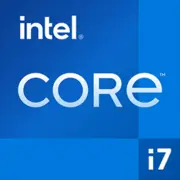Intel Core i7-10850H

Intel Core i7-10850H: Review of the 2025 Laptop Processor
Relevance in 2025: Is it worth considering Comet Lake?
Architecture and Manufacturing Process: Old but Reliable
The Intel Core i7-10850H, released in 2020, belongs to the Comet Lake generation and is still found in mid-range and premium laptops. Despite utilizing an outdated 14nm manufacturing process, it remains relevant due to architectural optimizations.
Key Specifications:
- 6 cores / 12 threads: Multitasking for heavy applications.
- Base Frequency: 2.7 GHz, Turbo Boost up to 5.1 GHz: High performance under peak loads.
- 12 MB L3 Cache: Accelerated data processing.
- Integrated Intel UHD Graphics for 10th Generation: Basic support for 4K displays and light gaming.
Architecture Features:
Comet Lake retained Hyper-Threading and support for DDR4-2933 memory but lags behind newer generations (Alder Lake, Meteor Lake) in energy efficiency. The integrated GPU, while weaker than discrete graphics cards, is suitable for office tasks and streaming video.
Power Consumption and TDP: Balancing Power and Heat
TDP 45W classifies the i7-10850H as a processor for high-performance laptops. However, in reality, power consumption can reach 80–90W in Turbo Boost mode, necessitating an efficient cooling system.
What does this mean for the user?
- In gaming laptops with powerful coolers, the processor can fully demonstrate its potential.
- In thin ultrabooks, throttling (frequency reduction due to overheating) may occur.
Tip: When purchasing, check reviews about the cooling system of the specific model. For example, the Dell XPS 15 with the i7-10850H shows stable performance, while some budget gaming laptops (like the Acer Nitro 5) may become noisy under load.
Performance: From Office to Gaming
Geekbench 6:
- Single-Core: 1467: Sufficient for quick responses in browsers and applications.
- Multi-Core: 5397: Suitable for rendering, video encoding, and parallel tasks.
Real-World Scenarios:
1. Office Work:
- Running 30+ tabs in Chrome + Microsoft Teams — no lags.
- Working in Excel with large spreadsheets — calculations take 15% less time than with the i5-10300H.
2. Multimedia:
- Rendering a 10-minute video in Premiere Pro (1080p) — ~12 minutes compared to ~8 minutes with the Ryzen 7 5800H.
- Streaming in OBS — stable with NVENC (Nvidia GPU).
3. Gaming:
- Paired with RTX 3060: Cyberpunk 2077 on medium settings — 50–60 FPS (1080p).
- Turbo mode increases FPS by 5–10%, but raises temperatures.
Turbo Boost Mode:
The maximum frequency (5.1 GHz) engages for a short duration (up to 30 seconds). For extended sessions, it’s more stable at 4.2–4.5 GHz.
Usage Scenarios: Who is the i7-10850H For?
1. Professionals:
- Video editors and designers seeking a balance between price and performance.
- Developers working with code compilation and virtual machines.
2. Gamers:
- For gaming at Full HD with a discrete graphics card (RTX 3050 and above).
3. Everyday Tasks:
- Users who value speed in multitasking (e.g., streaming + work).
Examples of 2025 laptops with the i7-10850H:
- HP Envy 16 (Price: $900–1100) — for creative tasks.
- Lenovo Legion 5 Pro (Price: $1000–1200) — gaming model with RTX 4060.
Battery Life: A Compromise with 45W TDP
Battery Life:
- During web surfing: 5–7 hours (depends on battery capacity).
- Under load: 1.5–2 hours.
Power-saving Technologies:
- Speed Shift — dynamic frequency management.
- Adaptix Thermal Framework — cooling optimization.
Tip: Choose laptops with a battery of at least 80Wh. For example, the MSI Creator Z16 with the i7-10850H and 90Wh provides up to 8 hours in reading mode.
Comparison with Competitors
1. AMD Ryzen 7 5800H (Zen 3, 7nm):
- Better for multi-threaded tasks (+20% in Cinebench R23).
- More energy-efficient but weaker in single-core performance.
2. Apple M2 (5nm):
- Half the power consumption, higher battery life.
- Compatibility only with macOS.
3. Intel Core i7-12800H (Alder Lake, 10nm):
+30% performance in multitasking but more expensive.
Conclusion: The i7-10850H falls short against new chips in efficiency but wins on price.
Pros and Cons
Strengths:
- High single-core performance.
- Affordable price (laptops starting at $800).
- Support for Thunderbolt 3 and Wi-Fi 6.
Weaknesses:
- Heating under load.
- Outdated 14nm process.
Recommendations for Choosing a Laptop
1. Types of Devices:
- Gaming: ASUS TUF Dash F15 — good cooling.
- Workstations: Dell Precision 3560 — supports ECC memory.
- Ultrabooks: Not recommended due to heat output.
2. What to Look For:
- Cooling system (minimum of 2 fans).
- Ports (preferably Thunderbolt 3 for external GPUs).
Final Recommendation: Who is the i7-10850H For?
This processor is worth considering if:
- You need a powerful laptop for $800–1200.
- Performance in applications sensitive to single-core (Photoshop, games) is a priority.
- You are okay with heat and noise from the fans.
Alternatives for 2025:
- For battery life — Apple MacBook Air M2 ($999).
- For multi-threading — Lenovo ThinkPad with Ryzen 7 6800H ($1100).
The Intel Core i7-10850H remains a solid choice for budget gamers and professionals but lags behind newer chips in energy efficiency.
Basic
CPU Specifications
Memory Specifications
GPU Specifications
Miscellaneous
Benchmarks
Compared to Other CPU
Share in social media
Or Link To Us
<a href="https://cputronic.com/cpu/intel-core-i7-10850h" target="_blank">Intel Core i7-10850H</a>